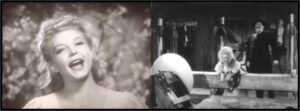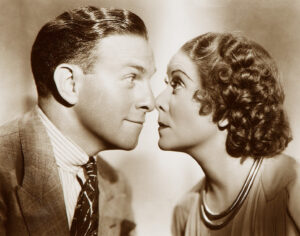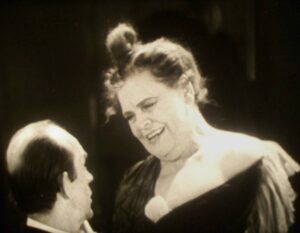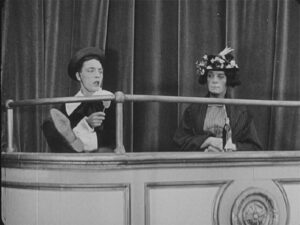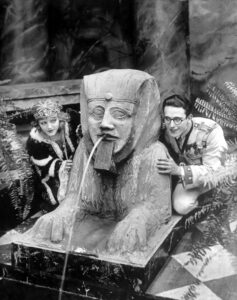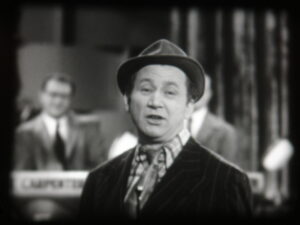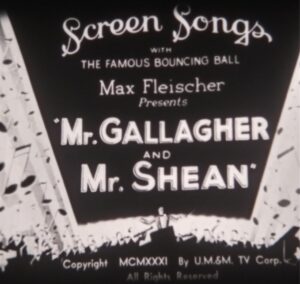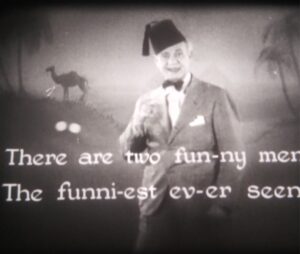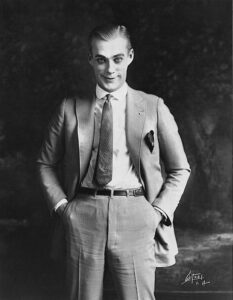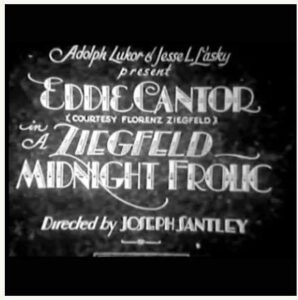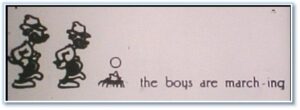“A DAY WITHOUT LAUGHTER IS A DAY WASTED.”
(French author Nicholas Chamfort, 1795)
Modern research indicates that Chamfort knew was he was talking about. Laughter is credited with reducing stress hormones, bolstering the immune system, lowering blood pressure, reducing pain and aiding in the healing process. Laughing is aerobic. It exercises the diaphragm and helps the body use oxygen.WE NEED MORE LAUGHTER!
Below are just some of the short comedy films available from Silver Showcase.
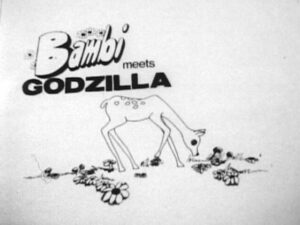
BAMBI MEETS GODZILLA (Marv Newland, April 13, 1969) Irreverent and wonderfully silly this was a student film that escaped the classroom to become a cult favorite. It was drawn in creator Marv Newland’s apartment in two weeks after he realized he didn’t have time to finish the live action film he was planning to submit to his professor at the Art Center College of Design in Los Angeles. Newland’s landlady at the time was Adrianna Caselotti who gave voice to Disney’s “Snow White” in 1937. Today Newland jokes that this film ruined his career. But the reality is that it helped to launch him to a distinguished career directing animated films for the National Film Board of Canada, “Sesame Street,” “Tales from the Far Side” and many other projects. (This print was struck in 2011 on Kodak film stock from Marv Newland’s negative, variable area sound track.)_______________________________________________ 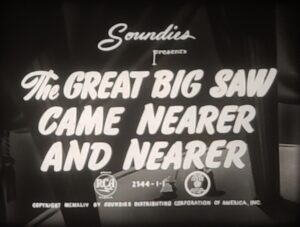
THE GREAT BIG SAW CAME NEARER AND NEARER (Soundie Corporation, released March 4, 1946) Sung by Cindy Walker, song written by R.P. Weston and Burt Lee. Produced and directed by Jack Shaindlin) Soundies were the music video format of 1942-1946. They were three minutes long and were watched on a coin operated 16mm rear-projection video juke box called a Panoram which you would find in various public venues such as restaurants, bars and pool halls. These musicals were spliced together with several other Soundies in a loop of film inside the Panoram. You would drop your nickel in the slot and the film that was next up on the loop would play for you. The selection might be swing music, a comic novelty song, jazz, country-western, polka, patriotic, you name it. |
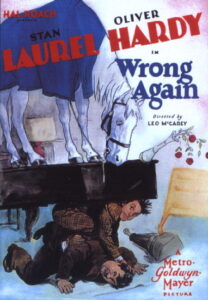
WRONG AGAIN (Hal Roach, February 23, 1929) Directed by Leo McCarey) For decades this great Laurel & Hardy film was unavailable to the public in it’s original form. Although a silent film, it was released with a music and sound effects track on disc, but those sound discs were missing and were not recovered until long after the Laurel & Hardy television revival of the 50s and 60s. Because of this, few people today have seen this film to advantage. It is now a favorite among some fans. People ask me to see “the one with the horse on the piano” again. Silver Showcase is proud to present this great comedy with that rediscovered 1929 music and sound effects track. To understand the goings-on all you really need to know is that there is a famous painting by Gainsborough titled “Blue Boy.” In this film Laurel (1890-1965) & Hardy (1892-1957) are stable hands taking care of a race horse by the name of Blue Boy. You can guess how the child-like minds of Laurel & Hardy respond when they learn that Blue Boy has been stolen. The opening stable scene was filmed at the Uplifters Club of Santa Monica, the same location used for “National Velvet” in 1944. (2004 Kodak film stock, variable area sound track).__________________________________________ |
|
______________________________________________________ 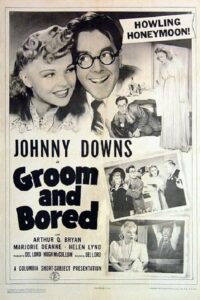
GROOM AND BORED (Columbia, April 9, 1942. Released by Official Films for home use in 1948.) Johnny Downs as Jimmy Warren, Marjorie Deanne as Marjorie Warren, Arthur Q. Bryan as Hotel Detective McGonigal, Helen Lynd as Dolly McGonigal, Bud Jamison as Train Conductor, Walter Soderling as Mr. Noe, Fred “Snowflake” Toones as Train Porter, Dudley Dickerson as Waiter Delivering Dinner, Stanley Brown as Desk Clerk, Symona Boniface as Train Passenger, Eddie Laughton as Train Passenger. Produced by Jules White. Directed by Del Lord. If you think this film looks like a 3 Stooges movie without the Stooges, you’re not far off. There are no eye pokes or face slaps, but there’s plenty of slapstick and other nonsense all played with high energy. The film was produced by Jules White who produced most of the Stooges’ films at Columbia, and directed by Del Lord, another long-time Stooge associate. Actors Symona Boniface and Bud Jamison, also have a strong association with Stooge films.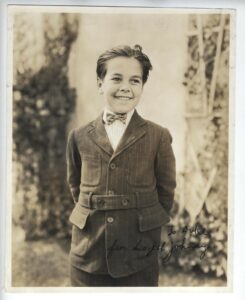 Johnny Downs (1913-1994) began his career as a member of Our Gang in the silent years. (See photo above.) When he outgrew that series he worked steadily in movies but was never an A-list star despite his matinee idol good looks.
Most viewers will immediately say to themselves that the Hotel Detective looks and sounds like Elmer Fudd. That is because Arthur Q. Bryan (1899-1959) was the long-time cartoon voice and live model for Elmer. While he also appeared on camera in movies and several television programs, Elmer Fudd is his lasting legacy. (1948 Kodak film stock, density sound track)
Johnny Downs (1913-1994) began his career as a member of Our Gang in the silent years. (See photo above.) When he outgrew that series he worked steadily in movies but was never an A-list star despite his matinee idol good looks.
Most viewers will immediately say to themselves that the Hotel Detective looks and sounds like Elmer Fudd. That is because Arthur Q. Bryan (1899-1959) was the long-time cartoon voice and live model for Elmer. While he also appeared on camera in movies and several television programs, Elmer Fudd is his lasting legacy. (1948 Kodak film stock, density sound track)
________________________________________________________ |
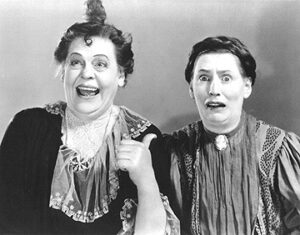
DANGEROUS FEMALES (Al Christie/Paramount, November 16, 1929) Marie Dressler (1868-1934, at left in photo above) was a force of nature. This Oscar winning actress was born in Coburg, Ontario, Canada, debuted in light opera at the age of 14 and a decade later was a leading comedienne of Broadway and Vaudeville. In 1914 she starred in the first feature-length comedy film, “Tillie’s Punctured Romance,” which was based on her Broadway hit of the same name. Her co-stars were Charles Chaplin and Mable Normand. In 1929 she landed a quick job at the now mostly forgotten Al Christie studio. (Christie competed with Hal Roach, churning out comedies.) The film was “Dangerous Females,” and Dressler’s co-star was the diminutive Polly Moran (1882-1952, at right in photo above). |
|
|
________________________________________________ 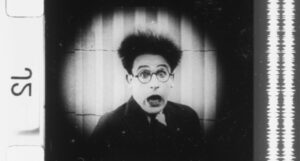
HIGH AND DIZZY (Hal Roach, July 11, 1920. Directed by Hal Roach) This was Harold Lloyd’s (1883-1971) second “thrill” comedy in which, through circumstances that are best seen in the film, he ends up balancing dangerously on the ledge of a building many stories above the street. His next thrill comedy was the feature-length “Safety Last” in which he famously hangs from the hands of a clock several stories above the street. Of Chaplin, Keaton and Lloyd, it is Lloyd’s glasses character who is the most normal, and for some the most accessible. He appears like so many average men we know. Of course, he becomes involved in situations that are anything but normal, but because of his pluck and sheer determination we know he will always succeed. Appearing with Lloyd in “High and Dizzy” are Mildred Davis (1901-1969) as “The Girl,” and Roy Brooks (1901-1976) as “His Friend.” In 1923 Davis became Mrs. Lloyd and retired from the screen. Her younger brother was Jack Davis, a member of the Our Gang cast in the silent era of those wonderful films. Brooks eventually became Lloyd’s business manager. The print we will see is the 2004 restoration of “High and Dizzy” with all the original and clever intertitle cards re-inserted, improved image quality and a great original musical accompaniment by the Paragon Ragtime Orchestra. (2004 ORWO film stock, variable area sound track.)_____________________________________________ |
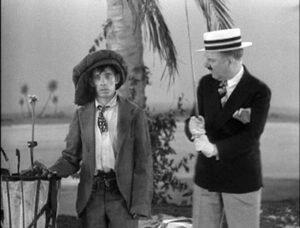
THE GOLF SPECIALIST (RKO Radio Pictures, August 22, 1930) W.C. Fields (1880-1946) made several silent films, but his humor was primarily verbal, so sound films are where he excelled. One of the benefits of early film is that some of them preserve entertainment that was popular on the live stage. “The Golf Specialist” is one such film. This “2 reeler,” was Field’s first sound film and preserves his classic golf routine that had proven so successful for him in several incarnations of the legendary Ziegfeld Follies on Broadway. Fields had performed it in previous silent films and would do it again in later talkies, but this time it was photographed indoors (at the Ideal Studio in Hudson Heights, New Jersey) instead of on a real golf course, and from primarily one camera angle so we get to see this classic routine very much as it would have played on the Ziegfeld stage, complete with Fields’ classic mumblings and exhortations. Fields also liked to toy with potential sexual situations as seen in the hotel lobby with the House Detective’s wife and later with the woman walking her dog. Twenty-first century audiences are often surprised at some of this humor in a movie from 1930. But this is what film collectors and historians refer to as a “pre-code” movie, meaning that it was made before the Hays Office cracked down in July of 1934 and began to firmly enforce the production code. (Undated 3M film stock, variable area sound track)_____________________________________________ 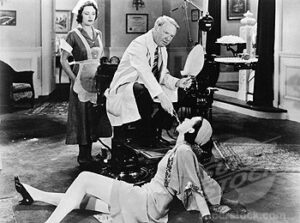
THE DENTIST (Mack Sennett, December 9, 1932) Famous W.C. Fields short film with the highly suggestive scene of the slinky woman (Elise Cavanna), in the dentist’s chair, (a scene that was sometimes censored for television). Fields also does his famous golf routine yet again. (1973 Eastman film stock, variable area sound track) |
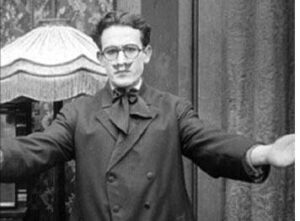
NON-STOP KID (Hal Roach, May 12, 1918) Harold impersonates Professor M. T Noodle to win the hand of wealthy Bebe Daniels. Snub Pollard is her butler. Superb image quality on this early “glasses character” film. Excellent theatre organ accompaniment by John Muri recorded at 18fps. (1976 Eastman stock, density sound track)__________________________________________ |
|
______________________________________________ 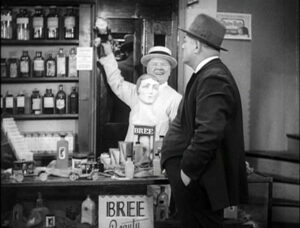
THE PHARMACIST (Mack Sennett, April 21, 1933) W.C. Fields runs a small town pharmacy beset with quirky customers. Absurdities abound. His main trade seems to be selling postage stamps and cough drops while avoiding the revenuer who is determined to nab Fields for selling booze. One Fields’ favorites, Elise Cavanna, is his troublesome wife, Babe Kane is his petulant daughter who eats canaries, and another Fields’ favorite, Grady Sutton of all people, saves the day from armed crooks. (1970 Eastman films stock, variable area sound track.) |
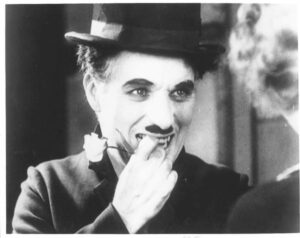
CHAPLIN UMBRELLA TRAILER (rbc films, 1974) Following his celebrated return visit to the United States and acceptance of a special Academy Award, Charles Chaplin (1889-1977) re-issued most of his features and some of his shorts. He wrote musical scores for his silent features and some of his shorts that did not already have a recorded score. Authorized by Chaplin, this very rare film is the “umbrella” trailer that was shown in theatres to promote the entire series. It features clips from “The Kid,” “The Gold Rush,” “The Circus,” “City Lights,” “Modern Times,” “The Great Dictator,” “Monsieur Verdoux,” “Limelight,” and “A King in New York.” There are also clips from the three shorts that make up “The Chaplin Revue:” “A Dog’s Life,” (watch for mustachioed Sydney, Chaplin’s brother, behind the lunch counter), “Shoulder Arms,” and “The Pilgrim.” It is an excellent way to get a taste of the deep and varied talents of Sir Charles Spencer Chaplin. All music in these great films was composed or selected by Charles Chaplin. (Undated 3M film stock, variable area sound track) |
|
______________________________________ 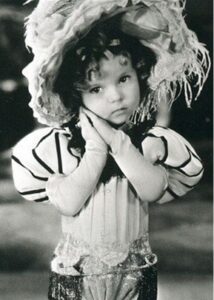
GLAD RAGS TO RICHES (Jack Hays Productions/Educational Film Exchanges, February 5, 1933) Directed by Charles Lamont. By her own account Shirley Temple (1928-2014) was discovered hiding behind a piano at the legendary Ethel Meglin School. Hollywood film producers often visited the Meglin school when looking to cast children in their films. Temple, Mickey Rooney, Ann Miller, Judy Garland, Dwayne Hickman and many other actors began their careers as Meglin Kiddies where they were taught to sing, dance and play instruments. Meglin Kiddies often appeared in Our Gang films when the script called for groups of children who could sing and dance. After being found behind that Meglin piano, Temple appeared in a forgotten short titled “Runt Page,” produced at Universal. This film featured toddlers wearing diapers with oversized safety pins and acting in adult situations. Then she moved to Educational Pictures, one of the poverty row studios that churned out inexpensive films. “Glad Rags to Riches” was the third in the Baby Burlesque films that used the same format at Temple’s film at Universal: little kids dressed as babies. Sharp eyes watching this film might notice the Educational Pictures slogan “The Spice of the Program,” on the poster promoting Temple’s character, “La Belle Diaparina.” Temple was just four years old at the time of filming, and she is billed fourth although she is clearly the focal point of the story. Aside from cute kids in diapers, the Baby Burlesk films featured dialog such as “…that I should find you in this den of iniquity.” That any child under five could effectively deliver such dialog is amazing. This is the Blackhawk Films edition/restoration from the 1970s of the Screencraft Pictures re-release. The surviving film elements had sections of distorted and badly faded sound at the beginning and at the end. No dialog was involved, only music, so Blackhawk replaced those parts of the sound track with some music that was clearly recorded later than the original film. (1976 Eastman film stock, variable area sound track)_______________________________________________ |
____________________ 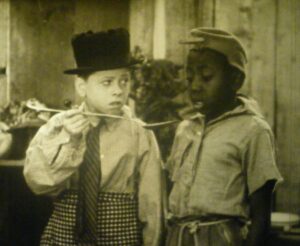
MICKEY’S MEDICINE MAN (Larry Darmour Productions, May 18, 1934) Mickey (Rooney) McGuire as Mickey McGuire, Billy Barty as Billy McGuire. Directed by Jesse Duffy. Mickey Rooney (1920–2014) began life as Joe Yule, Jr. His parents were show business veterans and first brought him on stage in their Vaudeville act when he was but seventeen months old. He landed his first film role at the age of five in the silent comedy short “Not to be Trusted,” which would be forgotten today had he not been in it. But a few months later he worked with the great silent star Coleen Moore in the comedy feature “Orchids and Ermine, (1927). He was so effective in his small role that people thought he was a tiny adult. This caught the eye of producer Larry Darmour who was looking to cast a young boy in a film series based on Fontaine Fox’s “Toonerville Trolly” comic strip. The strip ran in newspapers from 1908-1955. Darmour was cheap, shooting much of his films outside to save on studio and lighting costs. He convinced little Joe Yule’s parents to legally change the name of their boy to Mickey McGuire which also happened to be the name of the character he would play in the film series. He then claimed that he didn’t have to pay royalties to Fontaine Fox because the films were not based on the Toonerville Trolly comic strip, they were about this little boy who’s name really was Mickey McGuire. The courts didn’t buy it, so Darmour had to pay for the rights to shoot the films. The Mickey McGuire films were a success, rivaling the Our Gang films from the Hal Roach studio. Mickey was just six years old when the series began early in 1927. When sound came in the boy proved he had no trouble with dialog which only allowed his super-charged personality to shine even brighter. He stuck with the series until he was thirteen years old. His final Mickey McGuire film was the film we will see today, “Mickey’s Medicine Man.” Following Mickey’s departure from the series Darmour recast the part with another boy, but the spark just wasn’t there and the series soon ended. But Mickey McGuire, the actor, marched on. He was already appearing in big budget feature films such as “Manhattan Melodrama” with Clark Gable and “County Chairman” with Will Rogers, so his career was clearly in high gear. He changed his name to Mickey Rooney and never looked back. He worked in film, radio, television and the stage for an astonishing eighty-eight years until his death in 2014. His final appearance was in the comedy film “Holy Hollywood” which was released in 2021, seven and a half years after his death. This print is a 1947 reissue with replaced titles and Mickey’s last name changed in the credits from McGuire to Rooney. Other than that change, this is the original two reel version of this fun kid comedy. Sorry, we have no snake oil to sell for this event. (1947 Kodak film stock, variable area sound track) |
|
|
__________________________________________
A ZIEGFELD MIDNIGHT FROLIC (Paramount, May 4, 1929) Florence Ziegfeld’s famed Midnight Frolics in New York’s rooftop theatres are part of Broadway legend. They offered theatre goers who could afford the cover charge the chance to be entertained by some of Broadway’s biggest stars and prettiest chorus girls in an intimate setting. After the big stage show earlier in the evening, Will Rogers, Eddie Cantor and many other theatre legends kept the makeup on, went upstairs and continued telling jokes and singing songs into the wee hours of the morning. Although the Frolics had gone out of fashion some ten years earlier when Prohibition prevented Ziegfeld from selling alcoholic beverages at these intimate parties, in 1929 Ziegfeld attempted to bring them back and recreated a Frolic in New York’s Astoria film studio for the sound movie camera with Eddie Cantor as the star. It may have been staged just for the camera, but the film has the feel of a live performance with Cantor telling topical jokes and singing three novelty songs in his trade mark high energy style. This piece of history preserves a stand-up comedy performance by a young Eddie Cantor in his prime. Curiously, he’s in black face through the entire performance even though there is no minstrel material in this show. The reason for the black face is that he has supposedly just finished a performance of his hit Ziegfeld show, “Whoopie” in the main theatre downstairs. That 1929 hit Broadway musical ended with Cantor in black face for the final scene, so for this film he has supposedly just left the stage and has come directly upstairs to the Midnight Frolic stopping only to remove his wig. This film is a genuine piece of history and was presumed lost for several decades until a 35mm print turned up a few years ago. This print was struck directly from that one source. Other than some splices in that surviving 35mm print, image quality is superb. (Undated Eastman film stock, variable area sound track)________________________________________________
TRAMP TRAMP TRAMP (Inkwell Studios, May 8, 1926) Alfred Weiss presents The Screen Tune “Tramp, Tramp, Tramp.” Produced by S. Roy Luby. Music by Harold Veo’s Orchestra, Scored and Conducted by Jack Stillman. Recording Enginer — Mark S. Asch. “Tramp Tramp Tramp” is a very early synchronized sound cartoon that pre-dates Disney’s “Steamboat Willie” by two years! The Fleischer studio (Out of the Inkwell) had been experimenting with sound cartoons using the sound-on-film system introduced by the Lee DeForest labs in 1922. As most cinemas were not equipped for sound in 1926 this delightful cartoon would have been seen only in a specially equipped cinema or two in major cities such as New York, Chicago and Los Angeles. The film begins with a primitively animated but funny (and somewhat naughty) story of a soldier, (portrayed as an anthropomorphic dog) who goes AWOL to visit his girl friend. While in prison for that infraction he fashions a ball out of the rock pile and that becomes the bouncing ball that we follow to sing along with the song. The song “Tramp! Tramp! Tramp!” was written in 1864 by American music educator and prolific composer of popular and gospel songs as well as classical music, George F. Root, (1820-1895). Root also wrote “The Battle Cry of Freedom, and “Just before the Battle, Mother” among many other songs. Root wrote the song to bolster the spirits of Union soldiers in southern prisoner of war camps. An instant hit with the public, the song sold lots of sheet music, was performed by professional and amateur singers, and crossed the Mason/Dixon line into the Confederacy where the lyrics were adapted to champion their boys in grey. The melody was later used for the children’s Sunday School song “Jesus Loves the Little Children,” and for countless other songs around the world. George F. Root is no longer a household name but his song lives on. We will see this film projected from a very rare 16mm print that was struck in 2001 from the only known surviving copy which appears to have been sourced from a later generation film element. The contrast from the dupe renders one portion of the words too dark to read, but the animation is fun anyway. Unless better film elements turn up this is as good as this charming cartoon will ever look. (Kodak 08 2001 Mylar film stock, density sound track) |
